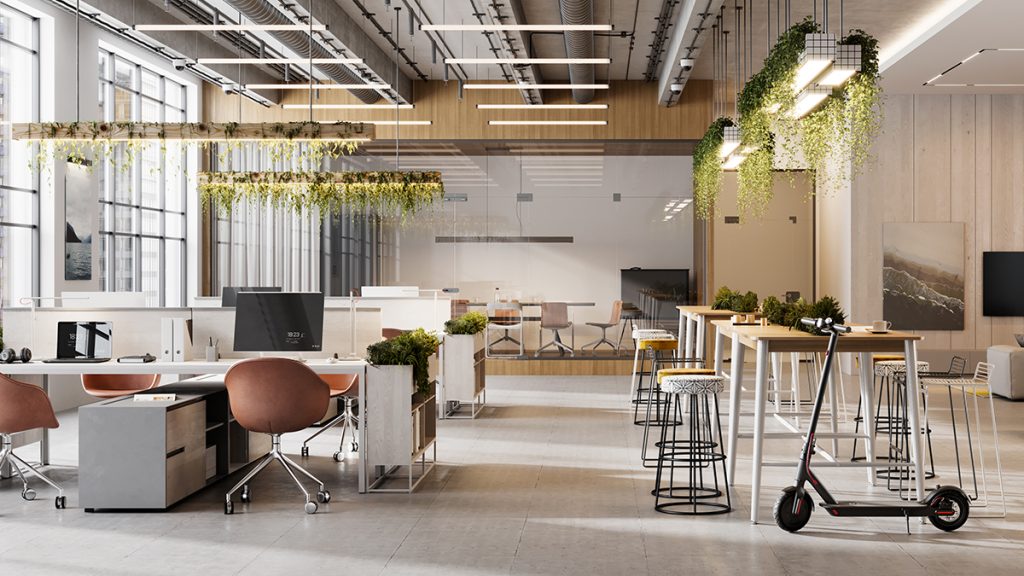Did you know that lighting consumes close to 35 percent of the electricity used in commercial buildings in the United States? Lighting can also affect other building systems, such as heating and cooling, that may work harder than necessary to mitigate the waste heat that inefficient lighting can produce.
Upgrades to a building’s lighting plan can pay for themselves many times over through the energy savings the improvements can yield. Here are five tips to lower costs by improving the efficiency of the lighting in any commercial building:
1. Take full advantage of daylight.
While natural light is almost always welcome on its own merits, it can also help reduce energy costs when it becomes an intentional component of the lighting plan. This practice, known as daylighting, utilizes strategies to collect, reflect, and redistribute natural light throughout a structure. For example, measures such as installing additional windows or skylights, transparent doors or partitions, and the addition of reflective finishes and surfaces can all promote the quantity and even distribution of light. According to the U.S. Department of Energy, harvesting available daylight sources can slash the electricity used for lighting in half during the daytime (when the demand and cost for energy are at their peak) and reduce a building’s total electricity consumption by up to 13 percent.
See the Whole Building Design Guide for more details on developing a daylighting system.
2. Replace fluorescent lights with LEDs.
Replacing fluorescent lights with LEDs is one of the most cost-effective building upgrades to make. Those making the switch to LED can expect to realize lower costs related to energy consumption, nearly no bulb maintenance or replacement costs, reduced total operating expenses over the long term, and may also qualify for utility rebates. Cost savings aside, LED lighting has also been proven to be more beneficial to the health of the building’s occupants.
To keep things simple and minimize downtime, you can choose to retrofit using LED kits that work with existing fixtures and circuits. However, a better option is to replace the old fixtures with new LED fixtures that allow greater customization. According to the Building Energy Exchange, installing more efficient fixtures and advanced controls can reduce lighting electricity use by up to 75% while retrofitting can yield energy savings of around 25%.
3. Put lighting controls to work.
Turning off unused lights doesn’t just make good economic sense— it’s ecologically responsible. Automated lighting controls allow fixtures to power on, turn off, or dim using timers, occupancy sensors, or present illumination levels:
- Time-based sensors are the simplest, allowing you to set a schedule to ensure lights are off when the building is unoccupied.
- Occupancy sensors, which use sound waves to detect presence and movement, can reduce lighting-related costs in a structure by up to 65%. Occupancy sensors are ideal for areas where people move less predictably, such as conference rooms and restrooms.
- Receptors that measure current illumination levels in a space can automatically dim lighting fixtures when natural light is sufficient, letting you leverage sunlight to lower energy use and costs.
4. Customize lighting levels by activity and task.
As noted in our paper on Lighting Surveys, lighting shouldn’t be treated with a uniformly prescriptive approach. Instead, effective lighting layouts account for the occupants’ lighting needs and what they are doing in the space. The chart below includes foot candle recommendations for some of the most common spaces and activities performed in commercial office buildings.
Many older office spaces blanket every area with the same ultra-bright overhead fluorescent lighting to light walkways and common areas and provide sufficient light for every workstation. A better approach is to employ personal task lights to illuminate each workstation. Articulating and dimmable task lights get light to where it’s needed most and are adjustable for each individual’s physical comfort or job function.
5. Add Up the Savings
Curious if a lighting upgrade is worthwhile for your facility? EnergyStar.gov provides a helpful cash flow opportunity calculator that translates energy savings into dollar figures and shows how energy efficiency projects can improve cash flow. The calculator estimates anticipated savings from new equipment installation and how much of the new equipment will be paid for by future savings. It can even help you decide if you should finance the upgrades or if a cash purchase is a better way to go. It sounds almost too good to be true, but the facts are well-established: lighting upgrades in commercial buildings can reduce energy use by half or more and pay for themselves, typically within a few years. In addition, upgrades can improve lighting quality and employee satisfaction, and the resulting improved energy efficiency is good for the environment. It’s a win-win-win for the bottom line, people, and the planet, and what’s not to love about that?


